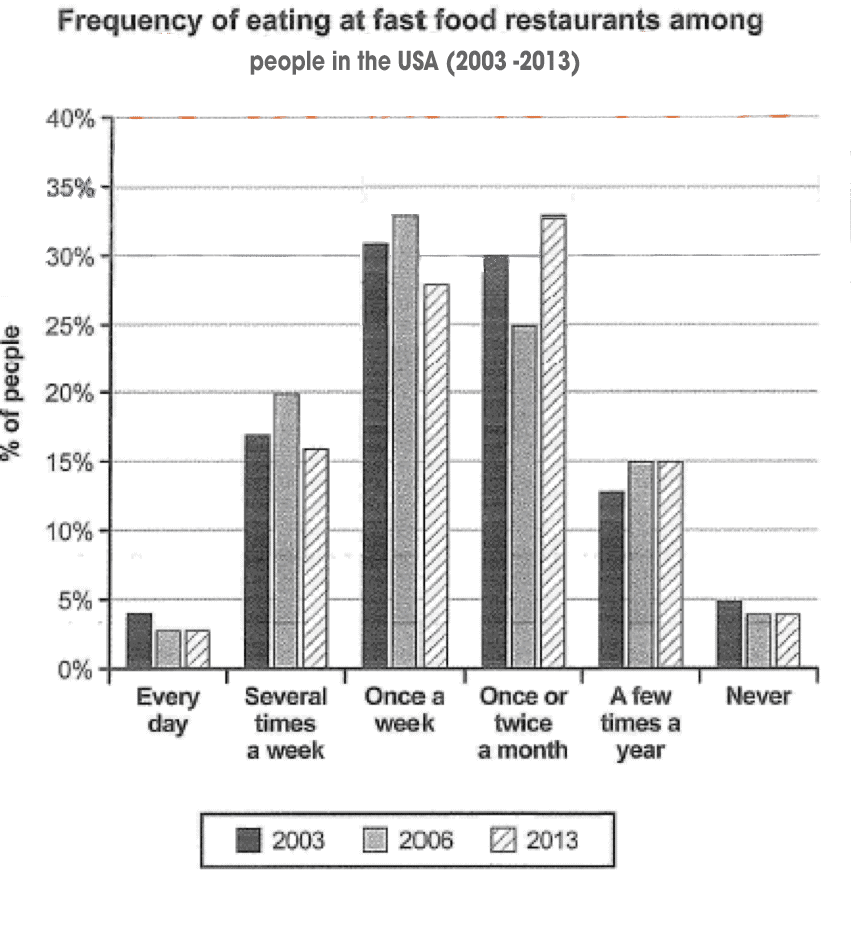Cam 12 Test 7 Writing Task 1
Summarise the information by selecting and reporting the main features, and make comparisons where relevant.

The bar chart illustrates the frequency of visits by Americans to fast food establishments between 2003 and 2013.
In general, the data reveals a shift in eating habits over the decade, with a decline in the frequency of visits to fast food outlets. Initially, in 2003 and 2006, the majority of Americans dined at fast food restaurants once a week. However, by 2013, the highest proportion of individuals visited these establishments only once or twice a month.
In 2003, approximately one-third of Americans patronized fast food restaurants on a weekly basis, slightly surpassing the percentage of those who visited once or twice per month. Over the following decade, the frequency of weekly visits experienced a modest increase of around 2% in 2006, followed by a decline of approximately 5% by 2013. Conversely, the proportion of individuals visiting once or twice per month saw an upward trend, rising from 25% in 2003 to approximately 33% by 2013.
Initially, around 17% of Americans frequented fast food establishments several times each week, while approximately 13% visited only a few times a year. These percentages remained relatively stable over the decade, hovering around 15% for both categories by 2013. Notably, the data also indicates that only about 5% of Americans refrained from dining at fast food restaurants, a figure slightly higher than the percentage of daily visitors. However, these percentages exhibited minimal variation over the ten-year period.
(197 words)
Bạn đang chuẩn bị cho kì thi IELTS?
Học IELTS Online qua ZOOM, bức band thần tốc
IELTS Thanh Loan – giáo viên 10 năm kinh nghiệm – trực tiếp đứng lớp, tự tin mang đến khóa học chất lượng nhất, phương pháp giảng dạy cô đọng dễ hiểu, giáo trình tự biên soạn cho lộ trình từ cơ bản đến luyện đề chuyên sâu. Đặc biệt, học viên luôn được quan tâm sát sao nhất, hỗ trợ không giới hạn, thúc đẩy kỷ luật học tập tốt để đạt mục tiêu.

Phân tích câu hỏi
Dạng câu hỏi: Bar chart có sự thay đổi theo thời gian
Cấu trúc bài viết
Introduction: Paraphrase lại đề bài
- how frequently → frequency (noun) / regularity (noun) → how many times
- eat = consume = use → choose
- fast food restaurant = fast food outlet
Overview: Nêu hai đặc điểm chính của biểu đồ
- 2003 và 2006: Hầu hết mọi người ăn 1 lần 1 tuần
- 2013: Hầu hết mọi người chỉ ăn 1-2 lần 1 tháng
Body paragraph 1: Mô tả hai số liệu cao nhất (once a week và once or twice a month)
Body paragraph 2: Mô tả các số liệu còn lại và sự thay đổi của chúng sau 10 năm
Từ vựng hay
- dine: Verb /daɪn/
Vietnamese meaning: ăn tối hoặc dùng bữa ăn chính trong một môi trường thoải mái và dễ chịu, thường là ở nhà hàng hoặc nhà ăn.
English meaning: To eat dinner or have the main meal of the day in a relaxed and comfortable setting, typically at a restaurant or dining hall. - patronize: Verb /ˈpeɪ.trə.naɪz/
Vietnamese meaning: ủng hộ, sử dụng dịch vụ hoặc mua hàng từ một cửa hàng, doanh nghiệp hoặc tổ chức nhất định.
English meaning: To support, use the services of, or buy goods from a particular shop, business, or organization. - surpass: Verb /sɚˈpæs/
Vietnamese meaning: vượt qua, vượt lên trên ai hoặc cái gì đó về chất lượng hoặc hiệu suất.
English meaning: To exceed or go beyond (someone or something) in quality or performance. - modest: Adjective /ˈmɑː.dɪst/
Vietnamese meaning: khiêm tốn, không tự kiêu, không quá nổi bật hoặc quá phô trương.
English meaning: Having or showing a moderate or humble estimate of one’s merits, importance, etc.; free from vanity, egotism, boastfulness, or great pretensions. - conversely: Adverb /ˈkɑːn.vɝːs.li/
Vietnamese meaning: ngược lại, dùng để chỉ sự phản đối hoặc sự tương phản giữa hai ý hay hai tình huống.
English meaning: In a way that is the opposite or reverse of something previously mentioned. - frequent (verb) /ˈfriː.kwənt/
Vietnamese meaning: thường xuyên đến một nơi, tham gia vào một hoạt động, hoặc sử dụng một dịch vụ một cách đều đặn.
English meaning: To visit a place, participate in an activity, or use a service regularly. - hover: Verb /ˈhʌv.ɚ/
Vietnamese meaning: bay nhẹ nhàng trong không khí, đặc biệt là ở một vị trí cố định gần một nơi nào đó.
English meaning: To remain in one place in the air, especially by moving the wings quickly. - refrain from: Verb phrase /rɪˈfreɪn frəm/
Vietnamese meaning: kiềm chế hoặc ngừng làm một điều gì đó, đặc biệt là điều gì đó mà bạn muốn làm nhưng biết rằng nó không phù hợp hoặc không tốt.
English meaning: To restrain or stop oneself from doing something, especially something that one wants to do but knows might be unwise or harmful. - minimal: Adjective /ˈmɪnɪməl/
Vietnamese meaning: tối thiểu, rất nhỏ hoặc ít nhất cần thiết.
English meaning: Of a minimum amount, quantity, or degree; negligible.
Lược dịch tiếng Việt
Biểu đồ bảng so sánh số lần người Mỹ ăn trong các cửa hàng thức ăn nhanh từ năm 2003 đến 2013.
Nhìn chung, hầu hết người Mỹ ăn trong các cửa hàng thức ăn nhanh mỗi tuần một lần vào năm 2003 và 2006, nhưng tần suất giảm đi vì vào năm 2013, hầu hết mọi người chỉ đến các cửa hàng thức ăn nhanh một hoặc hai lần một tháng.
Năm 2003, gần một phần ba người Mỹ đã dùng bữa tại các nhà hàng thức ăn nhanh mỗi tuần một lần, cao hơn một chút so với con số một hoặc hai lần mỗi tháng. Sau 10 năm, trong khi lượng người đến mỗi tuần 1 lần tăng khoảng 2% vào năm 2006 trước khi giảm khoảng 5% vào năm 2013, thì tỉ lệ người đến 1-2 lần mỗi tháng lại giảm rồi tăng, ở mức 25% và khoảng 33%.
Ban đầu, khoảng 17% người dân Hoa Kỳ ăn đồ ăn nhanh vài lần mỗi tuần, so với khoảng 13% những người chỉ ăn một vài lần trong năm. Cả hai tần số không thay đổi đáng kể, ghi nhận khoảng 15% mỗi năm 2013. Một sự thật đáng kinh ngạc là chỉ có khoảng 5% công dân ở Hoa Kỳ không ăn ở những nhà hàng này, cao hơn một chút so với con số cho người ăn hàng ngày, nhưng cả hai số liệu gần như không thay đổi theo thời gian.
[stu alias=”khoa_truy_cap_cac_bai_giai_de”]Xem thêm:
- Bài mẫu Writing Task 1 & 2 Cam 12 Test 1
- Bài mẫu Writing Task 1 & 2 Cam 12 Test 2
- Bài mẫu Writing Task 1 & 2 Cam 12 Test 3
- Bài mẫu Writing Task 1 & 2 Cam 12 Test 4
Đừng bỏ qua những cuốn sách cực hữu ích:
Cam 12 Test 7 Writing Task 2
In a number of countries, some people think it is necessary to spend large sums of money on constructing new railway lines for very fast trains between cities. Others believe the money should be spent on improving existing public transport.
Discuss both these views and give your own opinion.
Give reasons for your answer and include any relevant examples from your own knowledge or experience.
In various nations, there exists a debate over whether significant financial resources should be allocated to the construction of new high-speed railway lines connecting cities, or if those funds would be better invested in enhancing existing public transportation systems. In this essay, I will delve into both perspectives before providing my own viewpoint, which aligns with the latter.
Proponents of investing in new railway lines argue that high-speed trains offer numerous benefits, including reduced travel times between cities, increased connectivity, and economic development along the railway corridors. For instance, countries like Japan and France have implemented extensive high-speed rail networks, such as the Shinkansen and TGV, which have revolutionized travel and stimulated economic growth in their respective regions. Furthermore, the construction of new railway lines can create jobs and boost the economy through infrastructure projects.
However, I firmly believe that prioritizing the improvement of existing public transport systems is a more practical and beneficial approach. Many cities around the world are grappling with issues such as overcrowded buses and trains, inadequate infrastructure, and unreliable service. By allocating funds towards upgrading and expanding current public transit networks, governments can address these pressing concerns and provide better transportation options for commuters. For example, cities like London and Singapore have invested in modernizing their public transportation systems by introducing features such as contactless payment systems, real-time passenger information, and increased accessibility for individuals with disabilities. These improvements have resulted in smoother travel experiences, reduced congestion, and enhanced overall efficiency.
In conclusion, while the construction of new high-speed railway lines may offer certain advantages, I believe that improving existing public transport infrastructure should be the priority. By doing so, governments can address current transportation challenges, improve accessibility, and provide sustainable and efficient mobility solutions for their citizens.
(250 words)
Từ vựng hay
Tự học IELTS tại nhà chỉ từ 1.2 triệu?
Bằng Khóa học IELTS Online dạng video bài giảng
Giải pháp tự học IELTS tại nhà, tiết kiệm chi phí, linh hoạt thời gian nhưng đảm bảo hiệu quả. Khóa học dạng video bài giảng có lộ trình học từng ngày chi tiết. Học viên học lý thuyết qua video bài giảng, thực hành Listening Reading trực tiếp trên website, còn Writing Speaking được chấm chữa trực tiếp bởi cô Thanh Loan. Mọi bài giảng đều có tài liệu học tập đi kèm.

Lược dịch tiếng Việt
Mời bạn cùng tham gia cộng đồng “Học IELTS 0đ” trên Zalo cùng IELTS Thanh Loan, nhận những video bài giảng, tài liệu, dự đoán đề thi IELTS miễn phí và cập nhật













